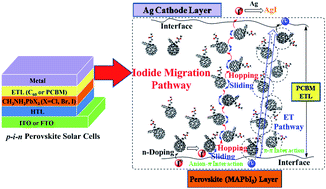当前位置:
X-MOL 学术
›
J. Mater. Chem. A
›
论文详情
Our official English website, www.x-mol.net, welcomes your
feedback! (Note: you will need to create a separate account there.)
Halide anion–fullerene π noncovalent interactions: n-doping and a halide anion migration mechanism in p–i–n perovskite solar cells
Journal of Materials Chemistry A ( IF 10.7 ) Pub Date : 2017-09-06 00:00:00 , DOI: 10.1039/c7ta06335k X. Sun 1, 2, 3, 4 , L. Y. Ji 1, 2, 3, 4 , W. W. Chen 1, 2, 3, 4 , X. Guo 5, 6, 7, 8, 9 , H. H. Wang 1, 2, 3, 4 , M. Lei 1, 2, 3, 4 , Q. Wang 1, 2, 3, 4 , Y. F. Li 5, 6, 7, 8, 9
Journal of Materials Chemistry A ( IF 10.7 ) Pub Date : 2017-09-06 00:00:00 , DOI: 10.1039/c7ta06335k X. Sun 1, 2, 3, 4 , L. Y. Ji 1, 2, 3, 4 , W. W. Chen 1, 2, 3, 4 , X. Guo 5, 6, 7, 8, 9 , H. H. Wang 1, 2, 3, 4 , M. Lei 1, 2, 3, 4 , Q. Wang 1, 2, 3, 4 , Y. F. Li 5, 6, 7, 8, 9
Affiliation

|
Iodide–fullerene π interactions play decisive roles in n-doping and electron transport of fullerenes at the perovskite–PCBM interface in the devices of perovskite solar cells (Pero-SCs). But instability issues of perovskites due to halide anion migration greatly limit the practical application of Pero-SCs. To fully understand the properties of these interactions, we conducted systematic studies on fullerene ammonium halides containing I−, Br−, and Cl− that exist in perovskites. Our findings show that fullerene is an overwhelmingly strong electron acceptor that activates relatively inert halide anions (Br− and Cl−) and initiates the n-doping process by forming anion–π interactions, which are closely related to the performance and stability of the p–i–n Pero-SC devices based on a CH3NH3PbX3 (X = I, Br, and Cl) light absorber and a fullerene (C60 or PCBM) electron transport layer (ETL). At the perovskite–fullerene interface in the p–i–n Pero-SC, n-doping occurs by forming iodide–fullerene π interactions, which facilitates charge transport and improves the performance of the devices by suppressing hysteresis. On the basis of experimental evidence and computational results, we propose a plausible mechanism for iodide migration attributed to its n-doping at the interface and subsequent hopping of slidable iodide to a neighbouring fullerene given that space and energy are favorable. Thus, the migration of halide anions through the fullerene layer results in perovskite degradation and performance decay of the devices. This work highlights the importance of halide anion–fullerene π interactions in materials chemistry and explores the introduction of a halide anion blocking ETL in p–i–n Pero-SCs.
中文翻译:

卤化物阴离子-富勒烯π非共价相互作用:p–i–n钙钛矿太阳能电池中的n掺杂和卤化物阴离子迁移机制
在钙钛矿型太阳能电池(Pero-SCs)的钙钛矿-PCBM界面,碘化物-富勒烯π相互作用在富勒烯的n掺杂和电子传输中起决定性作用。但是由于卤化物阴离子迁移而引起的钙钛矿的不稳定性问题极大地限制了Pero-SC的实际应用。要充分认识这些相互作用的性质,我们对富勒烯卤化铵进行了系统的研究包含我- ,溴-和Cl -存在于钙钛矿。我们的研究结果表明,富勒烯是一个极其强烈电子受体激活相对惰性的卤素阴离子(BR -和Cl -)并通过形成阴离子-π相互作用来启动n掺杂过程,这与基于CH 3 NH 3 PbX 3的p–i–n Pero-SC器件的性能和稳定性密切相关(X = I,Br和Cl)吸光剂和富勒烯(C 60或PCBM)电子传输层(ETL)。在p–i–n Pero-SC中的钙钛矿–富勒烯界面处,通过形成碘化物–富勒烯π相互作用而发生n掺杂,这有助于电荷传输并通过抑制磁滞来改善器件的性能。根据实验证据和计算结果,我们提出了一种合理的碘化物迁移机理,归因于其在界面处的n掺杂以及在空间和能量有利的情况下,碘化物向相邻富勒烯的跃迁。因此,卤化物阴离子通过富勒烯层的迁移导致钙钛矿的降解和器件的性能下降。这项工作强调了卤化物阴离子与富勒烯π相互作用在材料化学中的重要性,并探索了在p–i–n Pero-SC中引入卤化物阴离子阻断ETL的方法。
更新日期:2017-09-25
中文翻译:

卤化物阴离子-富勒烯π非共价相互作用:p–i–n钙钛矿太阳能电池中的n掺杂和卤化物阴离子迁移机制
在钙钛矿型太阳能电池(Pero-SCs)的钙钛矿-PCBM界面,碘化物-富勒烯π相互作用在富勒烯的n掺杂和电子传输中起决定性作用。但是由于卤化物阴离子迁移而引起的钙钛矿的不稳定性问题极大地限制了Pero-SC的实际应用。要充分认识这些相互作用的性质,我们对富勒烯卤化铵进行了系统的研究包含我- ,溴-和Cl -存在于钙钛矿。我们的研究结果表明,富勒烯是一个极其强烈电子受体激活相对惰性的卤素阴离子(BR -和Cl -)并通过形成阴离子-π相互作用来启动n掺杂过程,这与基于CH 3 NH 3 PbX 3的p–i–n Pero-SC器件的性能和稳定性密切相关(X = I,Br和Cl)吸光剂和富勒烯(C 60或PCBM)电子传输层(ETL)。在p–i–n Pero-SC中的钙钛矿–富勒烯界面处,通过形成碘化物–富勒烯π相互作用而发生n掺杂,这有助于电荷传输并通过抑制磁滞来改善器件的性能。根据实验证据和计算结果,我们提出了一种合理的碘化物迁移机理,归因于其在界面处的n掺杂以及在空间和能量有利的情况下,碘化物向相邻富勒烯的跃迁。因此,卤化物阴离子通过富勒烯层的迁移导致钙钛矿的降解和器件的性能下降。这项工作强调了卤化物阴离子与富勒烯π相互作用在材料化学中的重要性,并探索了在p–i–n Pero-SC中引入卤化物阴离子阻断ETL的方法。











































 京公网安备 11010802027423号
京公网安备 11010802027423号